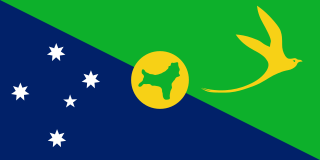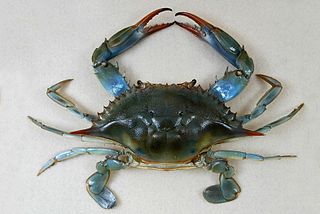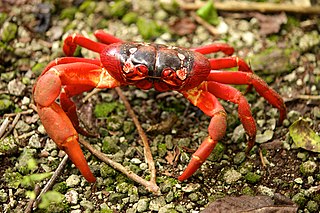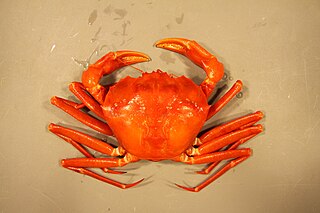Related Research Articles

The Territory of Christmas Island is an Australian external territory in the Indian Ocean comprising the island of the same name. It is located approximately 350 kilometres south of Java and Sumatra and about 1,550 km (840 nmi) north-west of the closest point on the Australian mainland. It has an area of 135 square kilometres (52 sq mi). The territory derives its name from its discovery on Christmas Day 1643 by Captain William Mynors.

The Bering Sea is a marginal sea of the Northern Pacific Ocean. It forms, along with the Bering Strait, the divide between the two largest landmasses on Earth: Eurasia and the Americas. It comprises a deep water basin, which then rises through a narrow slope into the shallower water above the continental shelves. The Bering Sea is named after Vitus Bering, a Danish-born Russian navigator, who, in 1728, was the first European to systematically explore it, sailing from the Pacific Ocean northward to the Arctic Ocean.

The yellow crazy ant, also known as the long-legged ant or Maldive ant, is a species of ant, thought to be native to West Africa or Asia. They have been accidentally introduced to numerous places in the world's tropics.

The red knot or just knot is a medium-sized shorebird which breeds in tundra and the Arctic Cordillera in the far north of Canada, Europe, and Russia. It is a large member of the Calidris sandpipers, second only to the great knot. Six subspecies are recognised.

Callinectes sapidus, the blue crab, Atlantic blue crab, or, regionally, the Maryland blue crab, is a species of crab native to the waters of the western Atlantic Ocean and the Gulf of Mexico, and introduced internationally.

The Christmas Island red crab is a species of land crab that is endemic to Christmas Island and Cocos (Keeling) Islands in the Indian Ocean. Although restricted to a relatively small area, an estimated 43.7 million adult red crabs once lived on Christmas Island alone, but the accidental introduction of the yellow crazy ant is believed to have killed about 10–15 million of these in recent years. Christmas Island red crabs make an annual mass migration to the sea to lay their eggs in the ocean. Although its population is under great assault by the ants, as of 2020 the red crab had not been assessed by the International Union for Conservation of Nature (IUCN) and it was not listed on their Red List. The crab's annual mass migration to the sea for spawning is described as an "epic" event. Millions emerge at the same time, halting road traffic and covering the ground in a thick carpet of crabs.
The Dales is a wetland site located at the western end of Christmas Island, an Australian external territory in the eastern Indian Ocean. The site has been recognised as being of international importance by designation under the Ramsar Convention on Wetlands.

Christmas Island International Airport is an airport located on Christmas Island, a territory of Australia in the Indian Ocean. The island is located 2,600 km (1,600 mi) northwest of the Western Australian city of Perth, 500 km (310 mi) south of the Indonesian capital, Jakarta, and 975 km (606 mi) east-northeast of the Cocos (Keeling) Islands.

Animal migration is the relatively long-distance movement of individual animals, usually on a seasonal basis. It is the most common form of migration in ecology. It is found in all major animal groups, including birds, mammals, fish, reptiles, amphibians, insects, and crustaceans. The cause of migration may be local climate, local availability of food, the season of the year or for mating.

The Christmas Island shrew, also known as the Christmas Island musk-shrew is an extremely rare or possibly extinct shrew from Christmas Island. It was variously placed as subspecies of the Asian gray shrew or the Southeast Asian shrew, but morphological differences and the large distance between the species indicate that it is an entirely distinct species.

Christmas Island National Park is a national park occupying most of Christmas Island, an Australian territory in the Indian Ocean southwest of Indonesia. The park is home to many species of animal and plant life, including the eponymous red crab, whose annual migration sees around 100 million crabs move to the sea to spawn. Christmas Island is the only nesting place for the endangered Abbott's booby and critically endangered Christmas Island frigatebird, and the wide range of other endemic species makes the island of significant interest to the scientific community.

The coconut crab is a terrestrial species of giant hermit crab, and is also known as the robber crab or palm thief. It is the largest terrestrial arthropod known, with a weight of up to 4.1 kg (9 lb). The distance from the tip of one leg to the tip of another can be as wide as 1 m. It is found on islands across the Indian and Pacific Oceans, as far east as the Gambier Islands, Pitcairn Islands and Caroline Island and as far west as Zanzibar. While its range broadly shadows the distribution of the coconut palm, the coconut crab has been extirpated from most areas with a significant human population such as mainland Australia and Madagascar.

Gecarcinus ruricola is a species of terrestrial crab. It is the most terrestrial of the Caribbean land crabs, and is found from western Cuba across the Antilles as far east as Barbados. Common names for G. ruricola include the purple land crab, black land crab, red land crab, and zombie crab.

Johngarthia lagostoma is a species of terrestrial crab that lives on Ascension Island and three other islands in the South Atlantic. It grows to a carapace width of 110 mm (4.3 in) on Ascension Island, where it is the largest native land animal. It exists in two distinct colour morphs, one yellow and one purple, with few intermediates. The yellow morph dominates on Ascension Island, while the purple morph is more frequent on Rocas Atoll. The species differs from other Johngarthia species by the form of the third maxilliped.

A number of lineages of crabs have evolved to live predominantly on land. Examples of terrestrial crabs are found in the families Gecarcinidae and Gecarcinucidae, as well as in selected genera from other families, such as Sesarma, although the term "land crab" is often used to mean solely the family Gecarcinidae.

Stylophora pistillata, commonly known as hood coral or smooth cauliflower coral, is a species of stony coral in the family Pocilloporidae. It is native to the Indo-Pacific region and is commonly used in scientific investigations.

Chaceon quinquedens, commonly known as the red deep-sea crab, but sold as Atlantic deep sea red crab, or simply Atlantic red crab or red crab, is a crab that lives in the Atlantic Ocean off the East Coast of the United States and Canada, from North Carolina to Nova Scotia, and in the Gulf of Mexico.

Migration, in ecology, is the large-scale movement of members of a species to a different environment. Migration is a natural behavior and component of the life cycle of many species of mobile organisms, not limited to animals, though animal migration is the best known type. Migration is often cyclical, frequently occurring on a seasonal basis, and in some cases on a daily basis. Species migrate to take advantage of more favorable conditions with respect to food availability, safety from predation, mating opportunity, or other environmental factors.

The wildlife of Christmas Island is composed of the flora and fauna of this isolated island in the tropical Indian Ocean. Christmas Island is the summit plateau of an underwater volcano. It is mostly clad in tropical rainforest and has karst, cliffs, wetlands, coasts and sea. It is a small island with a land area of 135 km2 (52 sq mi), 63% of which has been declared a National park. Most of the rainforest remains intact and supports a large range of endemic species of animals and plants.
Events from 2021 in Christmas Island.
References
- ↑ "Millions of bright red crabs shut down roads in Australia's Christmas Island in mass migration". The Washington Post .
- ↑ "This Australian island has an overpass for migrating crabs. See how it works - CNN Video". CNN .
- ↑ "Millions of cannibal crabs shut down roads in Australia as they migrate towards ocean". 17 November 2021.
- ↑ "Why 50 million crabs are shutting roads in Australia: 'They're turning up everywhere'" . Independent.co.uk . 17 November 2021. Archived from the original on 2022-05-07.
- ↑ Hall, Melanie (September 10, 2018). "Our beautiful planet: March of Christmas Island's red crabs". Deutsche Welle . Retrieved September 10, 2018.